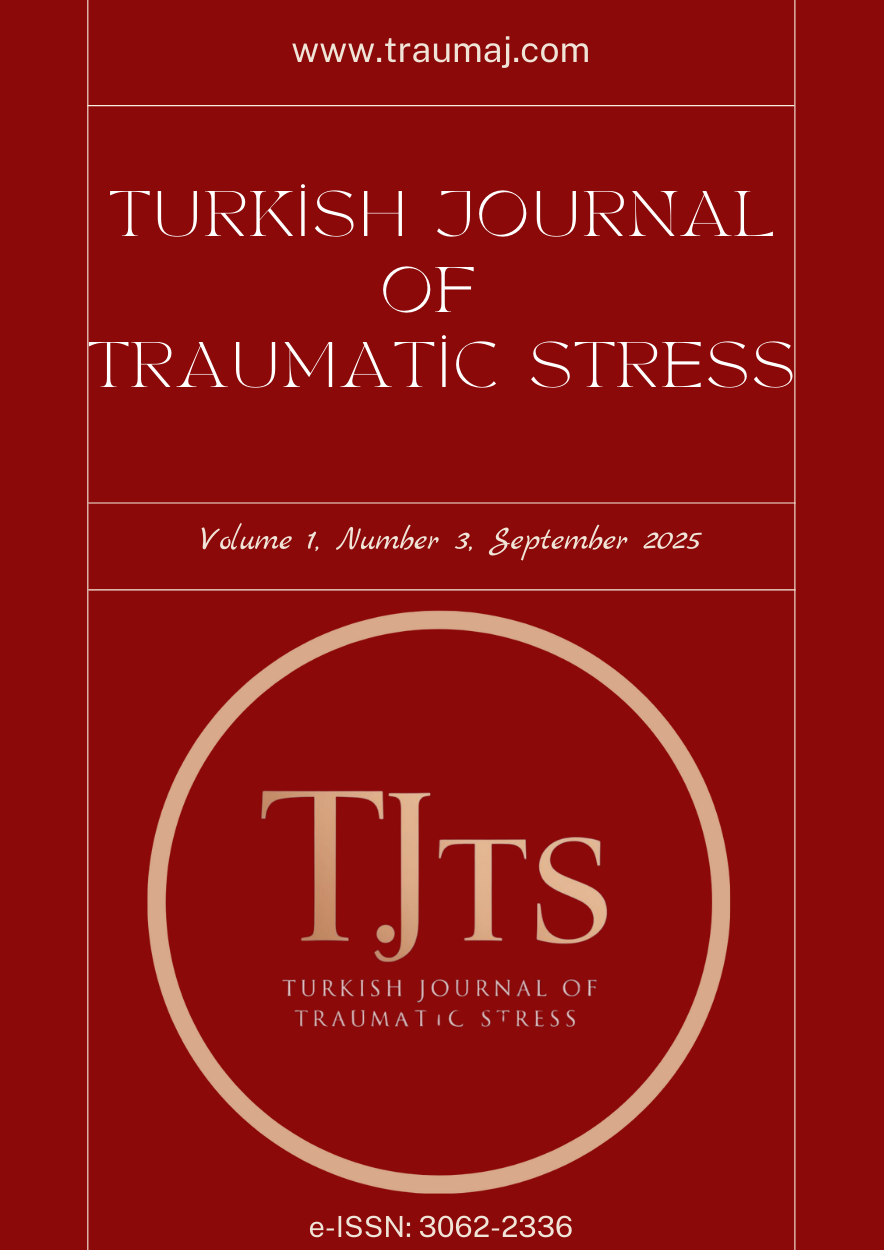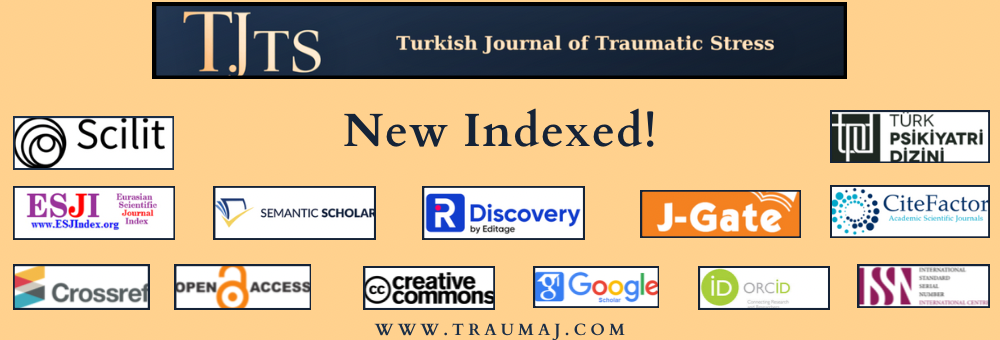Secondary Traumatization Among NGO Humanitarian Workers in the Aftermath of the 2023 Türkiye Earthquakes: Implications for Disaster Management Plans
Secondary Traumatization Among NGO Humanitarian Workers in the Aftermath of the 2023 Türkiye Earthquakes
DOI:
https://doi.org/10.63175/tjts.34Keywords:
Türkiye earthquakes, volunteers, secondary traumatization, disaster response, public health preparednessAbstract
Background: The global rise in disasters triggered by natural hazards has increased the urgency for effective and ethical disaster response. Volunteers are often the first to respond, providing critical support before formal aid systems are in place. This study investigates the phenomenon of secondary traumatization among NGO-affiliated humanitarian workers who responded to the 2023 earthquakes in Türkiye.
Methods: This cross-sectional study included 278 humanitarian workers; data were collected using a socio-demographic form and the Secondary Traumatic Stress Scale, and analyzed with parametric tests and multiple regression.
Results: Analysis identified significant predictors of secondary traumatic stress, including younger age, female gender, lack of disaster-specific training, and a self-reported need for psychological support (p < 0.05).
Conclusion: The findings emphasize the need to recognize and support vulnerable groups within the volunteer workforce. Structured training, supervision, and accessible mental health resources are vital for reducing the psychological burden on volunteers. As disasters become more frequent and severe, an urgent call to action is warranted: disaster management plans must prioritize volunteer protection and preparedness. Supporting volunteers' mental health strengthens individual resilience and enhances the overall effectiveness and sustainability of disaster response efforts.
References
1. Whittaker J, McLennan B, Handmer J. A review of informal volunteerism in emergencies and disasters: Definition, opportunities and challenges. Int J Disaster Risk Reduct. 2015;13:358-368. doi:10.1016/j.ijdrr.2015.07.010
2. Twigg J, Mosel I. Emergent groups and spontaneous volunteers in urban disaster response. Environ Urban. 2017;29(2):443-458. doi:10.1177/0956247817721413
3. Substance Abuse and Mental Health Services Administration (SAMHSA). Crisis Counseling Assistance and Training Program (CCP): Supplemental Instructions. Substance Abuse and Mental Health Services Administration; 2014.
4. Mao W, Agyapong VIO. The Role of Social Determinants in Mental Health and Resilience After Disasters: Implications for Public Health Policy and Practice. Front Public Health. 2021;9:658528. doi:10.3389/fpubh.2021.658528
5. Ruth BJ, Sisco S, Marshall JW. Public Health Social Work. In: Gehlert S, Browne T, eds. Handbook of Health Social Work. John Wiley & Sons, Inc.; 2019:93-118.
6. EM-DAT. The OFDA/CRED International Disaster Database. Published online 2023. www.emdat.be
7. Centre for Research on the Epidemiology of Disasters (CRED). Earthquakes in Türkiye; A Review from 1900 to Today. Issue No:72- CRED Crunch. CRED; 2023. https://files.emdat.be/2023/09/CredCrunch72.pdf
8. The Republic of Türkiye M of I The Disaster and Emergency Management Presidency. About AFAD. n . https://www.afad.gov.tr/afad-hakkinda
9. United Nations Office for the Coordination of Humanitarian Affairs. Türkiye Earthquake 2023 Humanitarian Response Overview, 30 June 2023.; 2023. https://reliefweb.int/report/turkiye/turkiye-earthquake-2023-humanitarian-response-overview-30-june-2023-entr
10. Galea S, Nandi A, Vlahov D. The epidemiology of post-traumatic stress disorder after disasters. Epidemiol Rev. 2005;27(1):78-91.
11. Bertinelli L, Mahé C, Strobl E. Earthquakes and mental health. World Dev. 2023;169:Article 106283.
12. Bonanno GA. Loss, trauma, and human resilience: Have we underestimated the human capacity to thrive after extremely aversive events. Am Psychol. 2004;59:2-28.
13. American Psychiatric Association. Diagnostic and Statistical Manual of Mental Disorders. (4, ed.). American Psychiatric Association; 1994.
14. Figley CR. Compassion fatigue as secondary traumatic stress disorder: An overview. In: Figley CR, ed. Compassion Fatigue: Coping with Secondary Traumatic Stress Disorder in Those Who Treat Traumatized. Routledge; 1995:1-20. https://www.researchgate.net/publication/245720535_Compassion_fatigue_as_secondary_traumatic_stress_disorder_An_overview
15. Choi GY. Secondary traumatic stress and empowerment among social workers working with family violence or sexual assault survivors. J Soc Work. 2017;17(3):358-378. doi:10.1177/1468017316640194
16. Lerias D, Byrne MK. Vicarious traumatization: Symptoms and predictors. Stress Health. 2003;19(3):129-138. doi:10.1002/smi.969
17. Ludick M, Figley CR. Toward a mechanism for secondary trauma induction and reduction: Reimagining a theory of secondary traumatic stress. Traumatology. 2016;23(1):112-123. doi:10.1037/trm0000096
18. Patwary MdM, Ashraf A, Swed S, et al. Natural disaster and mental health of emergency rescue workers: Lessons learned from Turkey-Syria earthquake. Ann Work Expo Health. 2023;67(8):1018-1021. doi:10.1093/annweh/wxad043
19. Bride B. Secondary traumatic stress. In: Figley CR, ed. Encyclopedia of Trauma: An Interdisciplinary Guide. Sage; 2012:600-602. https://www.researchgate.net/profile/Carol-Tosone/publication/277020410_Shared_Trauma/links/555f6e7008ae9963a118b245/Shared-Trauma.pdf
20. Lamothe ME, Boujut F, Zenasni F, Sultan S. To be or not to be empathic: The combined role of empathic concern and perspective taking in understanding burnout in general practice. BMC Fam Pract. 2014;15:15-15.
21. Nelson-McEvers JA. Measurement of Self-Care Agency in a Noninstitutionalized Elderly Population. Unpublished master’s thesis. Grand Valley State University; 1995. https://scholarworks.gvsu.edu/cgi/viewcontent.cgi?article=1239&context=theses
22. Bride BE, Robinson MM, Yegidis B, Figley CR. Development and validation of the Secondary Traumatic Stress Scale. Res Soc Work Pract. 2004;14(1):27-35. doi:10.1177/1049731503254106
23. Kahil A. An Assessment of Secondary Traumatic Stress in Those Who Engage in a Helping Behavior with People Who Have Traumatic Life Events. Master’s thesis. 2016. https://www.researchgate.net/publication/314177548_Travmatik_Yasantilari_Olan_Bireylere_Yardim_Davranisinda_Bulunan_Profesyonel_ve_Gonullulerin_Ikincil_Travmatik_Stres_Duzeylerinin_Incelenmesi
24. Gökçe G, Yılmaz B. Relief workers in disasters: Secondary traumatic stress and coping. Türkiye Klin Psychol - Spec Top. 2017;2(3):198-204.
25. Oral M, Tuncay T. Effectiveness of interpersonal psychotherapy based group social work intervention on depression and social problem solving levels of women diagnosed with major depression in Turkey: A mixed method research. Soc Soc Work. 2018;29(2):114-143.
26. Ushiro R, Nakayama K. Gender role attitudes of hospital nurses in Japan: their relation to burnout, perceptions of physician-nurse collaboration, evaluation of care, and intent to continue working. Jpn J Nurs Sci JJNS. 2010;7(1):55-64. doi:10.1111/j.1742-7924.2010.00138.x
27. Bahia VS, Takada LT, Caixeta L, et al. Prefrontal damage in childhood and changes in the development of personality: A case report. Dement Neuropsychol. 2013;7(1):132-135.
28. Miller BL, Cummings JL. The Human Frontal Lobes: Functions and Disorders. (Miller BL, Cummings JL, eds.). Guilford Press; 2007. https://psycnet.apa.org/record/2006-23347-000
29. Stuss DT, Knight RT. Principles of Frontal Lobe Function. (Stuss DT, Knight RT, eds.). Oxford University Press; 2007. doi:10.1093/med/9780199837755.001.0001
30. Woods SW. Chlorpromazine equivalent doses for the newer atypical antipsychotics. J Clin Psychiatry. 2003;64(6):663-667. doi:10.4088/jcp.v64n0607
Published
How to Cite
Issue
Section
License
Copyright (c) 2025 Elif Meydaneri, Zeynep Şimşek

This work is licensed under a Creative Commons Attribution 4.0 International License.








